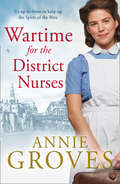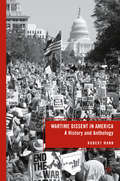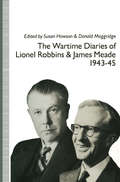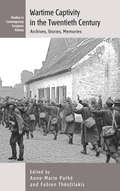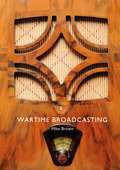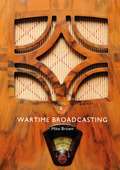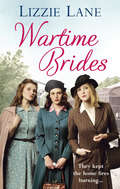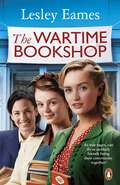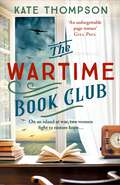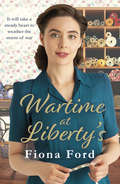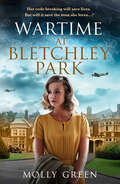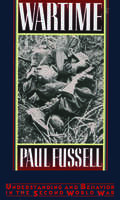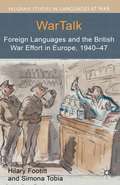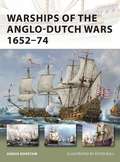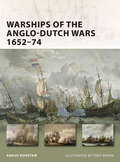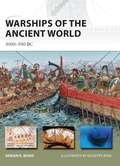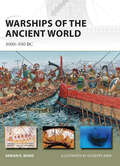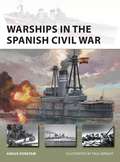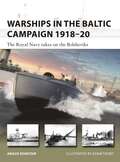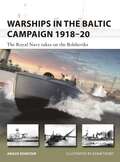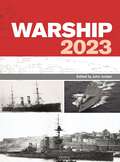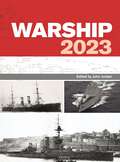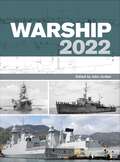- Table View
- List View
Wartime for the District Nurses (The District Nurse #2)
by Annie GrovesThe compelling new bestseller from the author of The Mersey Daughter and Winter on the Mersey.
Wartime Dissent in America: A History and Anthology
by R. MannThrough the speeches, essays and interviews of some of the most compelling individuals in American history who stood against the key conflicts of their lifetimes, this book gives remarkable insight into wartime dissent in the U.S. from the revolutionary war to the war on terror.
The Wartime Diaries of Lionel Robbins and James Meade, 1943–45
by Lionel Robbins James MeadeCovering the period 1943-45, these diaries cover issues such as the Bretton Woods UN Monetary Conference in 1944 and loan negotiations and the ITO, as recorded by Meade and Robbins.
Wartime Captivity in the 20th Century: Archives, Stories, Memories (Contemporary European History #19)
by Anne-Marie PathéLong a topic of historical interest, wartime captivity has over the past decade taken on new urgency as an object of study. Transnational by its very nature, captivity’s historical significance extends far beyond the front lines, ultimately inextricable from the histories of mobilization, nationalism, colonialism, law, and a host of other related subjects. This wide-ranging volume brings together an international selection of scholars to trace the contours of this evolving research agenda, offering fascinating new perspectives on historical moments that range from the early days of the Great War to the arrival of prisoners at Guantanamo Bay.
Wartime Broadcasting (Shire Library)
by Mike BrownOn 3 September 1939, Prime Minister Neville Chamberlain sat tensely at a microphone, using radio to declare that 'this country is at war with Germany'. During the ensuing wartime years, the BBC was the sole radio broadcaster in Britain, boosting morale through programmes such as 'ITMA' and 'Worker's Playtime'; helping the Home Front with useful hints and advice; transmitting government messages; and providing news. Personalities and stars became household names – Tommy Handley, Arthur Askey, Ethel and Doris Walters, Mr Middleton – and their catchphrases could be heard everywhere. And yet, as this fascinating book explains, the BBC chose to avoid propaganda, and had to tread a fine line between what the people wanted to hear and what it was felt they should hear.
Wartime Broadcasting (Shire Library)
by Mike BrownOn 3 September 1939, Prime Minister Neville Chamberlain sat tensely at a microphone, using radio to declare that 'this country is at war with Germany'. During the ensuing wartime years, the BBC was the sole radio broadcaster in Britain, boosting morale through programmes such as 'ITMA' and 'Worker's Playtime'; helping the Home Front with useful hints and advice; transmitting government messages; and providing news. Personalities and stars became household names – Tommy Handley, Arthur Askey, Ethel and Doris Walters, Mr Middleton – and their catchphrases could be heard everywhere. And yet, as this fascinating book explains, the BBC chose to avoid propaganda, and had to tread a fine line between what the people wanted to hear and what it was felt they should hear.
Wartime Brides
by Lizzie LaneThe war is over...In Bristol, three very different women wait for their loved ones to return home.But Edna’s fiancé returns badly crippled. And Charlotte’s husband comes back a very different creature to the kind, gentle man she remembers.And as for Polly, her GI boyfriend doesn’t come back at all, leaving her with a bun in the oven and a scandal in the making...Note: originally published as THE REST OF OUR LIVES, by Jeannie Johnson
The Wartime Bookshop: The first in a heart-warming WWII saga series about community and friendship, from the bestselling author (The Wartime Bookshop #1)
by Lesley EamesThe first in a brand-new nostalgic and heart-warming WWII series, perfect for fans of Donna Douglas and Elaine Everest.Alice is nursing an injured hand and a broken heart when she moves to the village of Churchwood at the start of WWII. She is desperate to be independent but worries that her injuries will make that impossible.Kate lives with her family on Brimbles Farm, where her father and brothers treat her no better than a servant. With no mother or sisters, and shunned by the locals, Kate longs for a friend of her own.Naomi is looked up to for owning the best house in the village. But privately, she carries the hurts of childlessness, a husband who has little time for her and some deep-rooted insecurities.With war raging overseas, and difficulties to overcome at home, friendship is needed now more than ever. Can the war effort and a shared love of books bring these women - and the community of Churchwood - together?**The fourth novel, Evacuees at the Wartime Bookshop, is available to pre-order now!**-------------------------------**Real readers are LOVING The Wartime Bookshop**'BRILLIANT''Oh I loved this book... please carry on the good writing''Wow what a brilliant start to a new series''Outstandingly fabulous, warm and inviting... so glad there is going to be a follow-on''I was only two pages in when I knew this would be a 5 star read... I honestly can't put my excitement into words at the thought of reading the next one'
The Wartime Book Club: the heart-warming and inspiring new novel of love, bravery and resistance in WW2
by Kate ThompsonJersey, 1943. Once a warm and neighbourly community, now German soldiers patrol the cobbled streets, imposing a harsh rule on the people of the island. Grace La Mottée, the island's only librarian, is ordered to destroy books which threaten the new regime. Instead, she hides the stories away in secret. Along with her headstrong best friend, postwoman Bea Rose, she wants to fight back. So she forms the wartime book club: a lifeline, offering fearful islanders the joy and escapism of reading. But as the occupation drags on, the women's quiet acts of bravery become more perilous - and more important - than ever before. And, when tensions turn to violence, they are forced to face the true, terrible cost of resistance . . . Based on astonishing real events, The Wartime Book Club is a love letter to the power of books in the darkest of times - as well as a moving page-turner that brings to life the remarkable, untold story of an island at war.EVERYONE LOVES THE WARTIME BOOK CLUB:'One of the very best books I've read in a long time. A gripping, emotional rollercoaster and a true hymn to the power and spirit of novels' Peter James'A poignant masterpiece that paints a vivid picture of Nazi-occupied life on the isle of Jersey' Madeline Martin'An engaging, beautifully researched story of love, courage and resistance in time of war and danger' Rachel Hore'Bravery, traitors, acts of defiance and compassion . . . [and] a beautiful and touching love story too' Pam Weaver'A wonderful, poignant, heartwarming story of the power of books and the strength of the human spirit' Louise Fein'This is a story of bravery and the cost of small acts of defiance . . . simply outstanding!' Andie Newton'An unforgettable page-turner' Gill Paul'A book to be savoured and remembered' Gill Thompson'With her brilliant research, Kate Thompson has brought this terrifying time vividly to life . . . a stunning novel' Suzanne Goldring'This, for me, is historical fiction at its finest - a story of believable, vividly-drawn people trying to live in a world so very different from our own - and I loved it from start to finish' Anna Stuart
Wartime at Liberty's
by Fiona FordLondon, 1942Flo Canning’s heart is beyond repair following the news that she has been dreading since the outbreak of war. As Flo throws herself into the role of fabric manager at Liberty’s, old and new friends alike help pull her from a whirl of despair. Between work and home life there’s plenty to keep Flo occupied. Not least new deputy store manager, Henry Masters, whose arrival has consequences that Flo and her workmates could never have foreseen.But there is more tragedy still to come, and Flo and her friends will need each other more than ever if they are to survive the uncertainty ahead.
Wartime at Bletchley Park (The Bletchley Park Girls #1)
by Molly Green⭐ The new sweeping WW2 historical series from Molly Green: available to pre-order now! ⭐ Her code breaking will save lives.But will it save the man she loves…?
Wartime: Understanding and Behavior in the Second World War
by Paul FussellWinner of both the National Book Award for Arts and Letters and the National Book Critics Circle Award for Criticism, Paul Fussell's The Great War and Modern Memory was one of the most original and gripping volumes ever written about the First World War. Frank Kermode, in The New York Times Book Review, hailed it as "an important contribution to our understanding of how we came to make World War I part of our minds," and Lionel Trilling called it simply "one of the most deeply moving books I have read in a long time." In its panaramic scope and poetic intensity, it illuminated a war that changed a generation and revolutionized the way we see the world. Now, in Wartime, Fussell turns to the Second World War, the conflict he himself fought in, to weave a narrative that is both more intensely personal and more wide-ranging. Whereas his former book focused primarily on literary figures, on the image of the Great War in literature, here Fussell examines the immediate impact of the war on common soldiers and civilians. He describes the psychological and emotional atmosphere of World War II. He analyzes the euphemisms people needed to deal with unacceptable reality (the early belief, for instance, that the war could be won by "precision bombing," that is, by long distance); he describes the abnormally intense frustration of desire and some of the means by which desire was satisfied; and, most important, he emphasizes the damage the war did to intellect, discrimination, honesty, individuality, complexity, ambiguity and wit. Of course, no Fussell book would be complete without some serious discussion of the literature of the time. He examines, for instance, how the great privations of wartime (when oranges would be raffled off as valued prizes) resulted in roccoco prose styles that dwelt longingly on lavish dinners, and how the "high-mindedness" of the era and the almost pathological need to "accentuate the positive" led to the downfall of the acerbic H.L. Mencken and the ascent of E.B. White. He also offers astute commentary on Edmund Wilson's argument with Archibald MacLeish, Cyril Connolly's Horizon magazine, the war poetry of Randall Jarrell and Louis Simpson, and many other aspects of the wartime literary world. Fussell conveys the essence of that wartime as no other writer before him. For the past fifty years, the Allied War has been sanitized and romanticized almost beyond recognition by "the sentimental, the loony patriotic, the ignorant, and the bloodthirsty." Americans, he says, have never understood what the Second World War was really like. In this stunning volume, he offers such an understanding.
Wartime: Understanding and Behavior in the Second World War
by Paul FussellWinner of both the National Book Award for Arts and Letters and the National Book Critics Circle Award for Criticism, Paul Fussell's The Great War and Modern Memory was one of the most original and gripping volumes ever written about the First World War. Frank Kermode, in The New York Times Book Review, hailed it as "an important contribution to our understanding of how we came to make World War I part of our minds," and Lionel Trilling called it simply "one of the most deeply moving books I have read in a long time." In its panaramic scope and poetic intensity, it illuminated a war that changed a generation and revolutionized the way we see the world. Now, in Wartime, Fussell turns to the Second World War, the conflict he himself fought in, to weave a narrative that is both more intensely personal and more wide-ranging. Whereas his former book focused primarily on literary figures, on the image of the Great War in literature, here Fussell examines the immediate impact of the war on common soldiers and civilians. He describes the psychological and emotional atmosphere of World War II. He analyzes the euphemisms people needed to deal with unacceptable reality (the early belief, for instance, that the war could be won by "precision bombing," that is, by long distance); he describes the abnormally intense frustration of desire and some of the means by which desire was satisfied; and, most important, he emphasizes the damage the war did to intellect, discrimination, honesty, individuality, complexity, ambiguity and wit. Of course, no Fussell book would be complete without some serious discussion of the literature of the time. He examines, for instance, how the great privations of wartime (when oranges would be raffled off as valued prizes) resulted in roccoco prose styles that dwelt longingly on lavish dinners, and how the "high-mindedness" of the era and the almost pathological need to "accentuate the positive" led to the downfall of the acerbic H.L. Mencken and the ascent of E.B. White. He also offers astute commentary on Edmund Wilson's argument with Archibald MacLeish, Cyril Connolly's Horizon magazine, the war poetry of Randall Jarrell and Louis Simpson, and many other aspects of the wartime literary world. Fussell conveys the essence of that wartime as no other writer before him. For the past fifty years, the Allied War has been sanitized and romanticized almost beyond recognition by "the sentimental, the loony patriotic, the ignorant, and the bloodthirsty." Americans, he says, have never understood what the Second World War was really like. In this stunning volume, he offers such an understanding.
WarTalk: Foreign Languages and the British War Effort in Europe, 1940-47 (Palgrave Studies in Languages at War)
by Hilary Footitt Simona TobiaOffering a new perspective on the British experience of the Second World War in Europe, this book provides a series of snapshots of the role which languages played in the key processes of British war-making, moving from frameworks of perception and intelligence gathering, through to liberation/occupation, and on to the aftermath of conflict.
Warships of the Anglo-Dutch Wars 1652–74 (New Vanguard)
by Peter Bull Angus KonstamThree times during the 17th century, England and Holland went to war as part of an ongoing struggle for economic and naval supremacy. Primarily fought in the cold waters of the North Sea and the English Channel, the wars proved revolutionary in their impact upon warship design, armament, and naval tactics. During this time, the warship evolved into the true ship-of-the-line that would dominate naval warfare until the advent of steam power. This book traces the development of these warships in the context of the three Anglo–Dutch wars.
Warships of the Anglo-Dutch Wars 1652–74 (New Vanguard #183)
by Angus KonstamThree times during the 17th century, England and Holland went to war as part of an ongoing struggle for economic and naval supremacy. Primarily fought in the cold waters of the North Sea and the English Channel, the wars proved revolutionary in their impact upon warship design, armament, and naval tactics. During this time, the warship evolved into the true ship-of-the-line that would dominate naval warfare until the advent of steam power. This book traces the development of these warships in the context of the three Anglo–Dutch wars.
Warships of the Ancient World: 3000–500 BC (New Vanguard)
by Giuseppe Rava Adrian K. WoodThe world's first war machines were ships built two millennia before the dawn of the Classical world. Their influence on the course of history cannot be overstated. A wide variety of galleys and other types of warships were built by successive civilisations, each with their own distinctive appearance, capability and utility. The earliest of these were the Punt ships and the war galleys of Egypt which defeated the Sea People in the first known naval battle. Following the fall of these civilisations, the Phoenicians built biremes and other vessels, while in Greece the ships described in detail in the 'Trojan' epics established a tradition of warship building culminating in the pentekonters and triaconters. The warships of the period are abundantly illustrated on pottery and carved seals, and depicted in inscriptions and on bas-reliefs. The subject has been intensively studied for two and a half millennia, culminating in the contemporary works of authoritative scholars such as Morrison, Wallinga, Rodgers and Casson. To date there are no works covering the subject which are accessible and available to non-academics.
Warships of the Ancient World: 3000–500 BC (New Vanguard #196)
by Adrian K. WoodThe world's first war machines were ships built two millennia before the dawn of the Classical world. Their influence on the course of history cannot be overstated. A wide variety of galleys and other types of warships were built by successive civilisations, each with their own distinctive appearance, capability and utility. The earliest of these were the Punt ships and the war galleys of Egypt which defeated the Sea People in the first known naval battle. Following the fall of these civilisations, the Phoenicians built biremes and other vessels, while in Greece the ships described in detail in the 'Trojan' epics established a tradition of warship building culminating in the pentekonters and triaconters. The warships of the period are abundantly illustrated on pottery and carved seals, and depicted in inscriptions and on bas-reliefs. The subject has been intensively studied for two and a half millennia, culminating in the contemporary works of authoritative scholars such as Morrison, Wallinga, Rodgers and Casson. To date there are no works covering the subject which are accessible and available to non-academics.
Warships in the Spanish Civil War (New Vanguard)
by Angus KonstamThis detailed study of the naval Spanish Civil War describes how the Spanish Navy, torn in two and comprising a Republican and Nationalist part, fought a civil war at sea involving both Hitler's and Mussolini's navies.In July 1936, a pro-fascist coup orchestrated by General Franco tore Spain apart and plunged the country into a bitter civil war. Like Spain itself, the Spanish Navy was torn in two: crews and most ships remained loyal to the Republican government but many of the Navy's officers joined Franco's rebels, and warships under repair or 'mothballed' in southern ports soon fell to the rebel advance. These formed the basis of Franco's 'Nationalist fleet,' and with both Italian and German help, the rebels were able to contest the Republic's control of Spanish waters. Overall the Republican Navy held its own, despite mounting losses, until the collapse of the Republican Army led to the fleet seeking internment in French North Africa. Packed with contemporary photographs and full colour illustrations, this study examines the composition and organization of the two rival fleets, the capabilities of their ships and submarines, and the performance of their crews. It also covers the warships of the Basque Auxiliary Navy - an offshoot of the Republican Fleet - and other navies who played a part in the conflict, most notably the Italian Regia Marina.
Warships in the Spanish Civil War (New Vanguard)
by Angus KonstamThis detailed study of the naval Spanish Civil War describes how the Spanish Navy, torn in two and comprising a Republican and Nationalist part, fought a civil war at sea involving both Hitler's and Mussolini's navies.In July 1936, a pro-fascist coup orchestrated by General Franco tore Spain apart and plunged the country into a bitter civil war. Like Spain itself, the Spanish Navy was torn in two: crews and most ships remained loyal to the Republican government but many of the Navy's officers joined Franco's rebels, and warships under repair or 'mothballed' in southern ports soon fell to the rebel advance. These formed the basis of Franco's 'Nationalist fleet,' and with both Italian and German help, the rebels were able to contest the Republic's control of Spanish waters. Overall the Republican Navy held its own, despite mounting losses, until the collapse of the Republican Army led to the fleet seeking internment in French North Africa. Packed with contemporary photographs and full colour illustrations, this study examines the composition and organization of the two rival fleets, the capabilities of their ships and submarines, and the performance of their crews. It also covers the warships of the Basque Auxiliary Navy - an offshoot of the Republican Fleet - and other navies who played a part in the conflict, most notably the Italian Regia Marina.
Warships in the Baltic Campaign 1918–20: The Royal Navy takes on the Bolsheviks (New Vanguard)
by Angus KonstamA fascinating look at the British naval intervention in the Baltic in 1918–20, and at the British, Soviet and Baltic nationalist fleets that fought.Following the Russian Revolution of October 1917, the Baltic states became a battleground between Russian Reds and Whites, German troops and emerging Baltic independence forces. In November 1918, the British government decided to intervene, to protect British interests and to support the emerging Baltic states. This initial small force of cruisers and destroyers was eventually augmented by other British warships, including aircraft carriers, a monitor, as well as a handful of submarines and torpedo boats. Opposing them was the far more powerful Russian Baltic Fleet, now controlled by the Bolsheviks. The campaign that followed involved naval clashes between the two sides, the most spectacular of which was an attack on the Soviet naval base of Kronstadt in June 1919 by a force of small British torpedo boats. They torpedoed and sunk the Russian cruiser Oleg, an action which effectively bottled the Baltic fleet up in port for the remainder of the campaign. Finally, in early 1920, the British squadron was withdrawn, following Soviet recognition of Estonia, Latvia and Lithuania. This New Vanguard title explores the naval side of this little-known but strategically crucial campaign fought by the war-weary navies of Britain and Russia and by warships of the emerging Baltic states. Describing the political background to the conflict, and the key points of the naval campaign as well as the warships involved, this is a concise and fascinating account of an overlooked naval campaign that helped reshape the map of Europe.
Warships in the Baltic Campaign 1918–20: The Royal Navy takes on the Bolsheviks (New Vanguard)
by Angus KonstamA fascinating look at the British naval intervention in the Baltic in 1918–20, and at the British, Soviet and Baltic nationalist fleets that fought.Following the Russian Revolution of October 1917, the Baltic states became a battleground between Russian Reds and Whites, German troops and emerging Baltic independence forces. In November 1918, the British government decided to intervene, to protect British interests and to support the emerging Baltic states. This initial small force of cruisers and destroyers was eventually augmented by other British warships, including aircraft carriers, a monitor, as well as a handful of submarines and torpedo boats. Opposing them was the far more powerful Russian Baltic Fleet, now controlled by the Bolsheviks. The campaign that followed involved naval clashes between the two sides, the most spectacular of which was an attack on the Soviet naval base of Kronstadt in June 1919 by a force of small British torpedo boats. They torpedoed and sunk the Russian cruiser Oleg, an action which effectively bottled the Baltic fleet up in port for the remainder of the campaign. Finally, in early 1920, the British squadron was withdrawn, following Soviet recognition of Estonia, Latvia and Lithuania. This New Vanguard title explores the naval side of this little-known but strategically crucial campaign fought by the war-weary navies of Britain and Russia and by warships of the emerging Baltic states. Describing the political background to the conflict, and the key points of the naval campaign as well as the warships involved, this is a concise and fascinating account of an overlooked naval campaign that helped reshape the map of Europe.
Warship 2023
by John JordanThe latest edition of Warship, the celebrated annual publication featuring the latest research on the history, development, and service of the world's warships.For over 45 years, Warship has been the leading annual resource on the design, development, and deployment of the world's combat ships. Featuring a broad range of articles from a select panel of distinguished international contributors, this latest volume combines original research, new book reviews, warship notes, an image gallery, and much more, maintaining the impressive standards of scholarship and research with which Warship has become synonymous. Detailed and accurate information is the keynote of all the articles, which are fully supported by plans, data tables, and stunning photographs.This year's Warship includes features on the secret battleship design that Mussolini's Fascist Italy sold to Stalin's USSR, the little-known German flak ships of World War II, the French aircraft carriers Clemenceau and Foch, and the development of electronic warfare in the Royal Navy.
Warship 2023
by John JordanThe latest edition of Warship, the celebrated annual publication featuring the latest research on the history, development, and service of the world's warships.For over 45 years, Warship has been the leading annual resource on the design, development, and deployment of the world's combat ships. Featuring a broad range of articles from a select panel of distinguished international contributors, this latest volume combines original research, new book reviews, warship notes, an image gallery, and much more, maintaining the impressive standards of scholarship and research with which Warship has become synonymous. Detailed and accurate information is the keynote of all the articles, which are fully supported by plans, data tables, and stunning photographs.This year's Warship includes features on the secret battleship design that Mussolini's Fascist Italy sold to Stalin's USSR, the little-known German flak ships of World War II, the French aircraft carriers Clemenceau and Foch, and the development of electronic warfare in the Royal Navy.
Warship 2022
by John JordanA celebrated annual publication featuring the latest research on history, development, and service of the world's warships.For 45 years, Warship has been the leading annual resource on the design, development, and deployment of the world's combat ships. Featuring a broad range of articles from a select panel of distinguished international contributors, this latest volume combines original research, new book reviews, warship notes, an image gallery, and much more, maintaining the impressive standards of scholarship and research with which Warship has become synonymous. Detailed and accurate information is the keynote of all the articles, which are fully supported by plans, data tables, and stunning photographs.The varied topics in this year's annual includes articles on the Imperial Japanese Navy carriers Soryu and Hiryu, post-war radar development in the Royal Navy, gunboats in the Imperial German Navy, Soviet battleship designs of the early Second World War, modern European frigates, and the origins of the Yokosuka naval yard.
